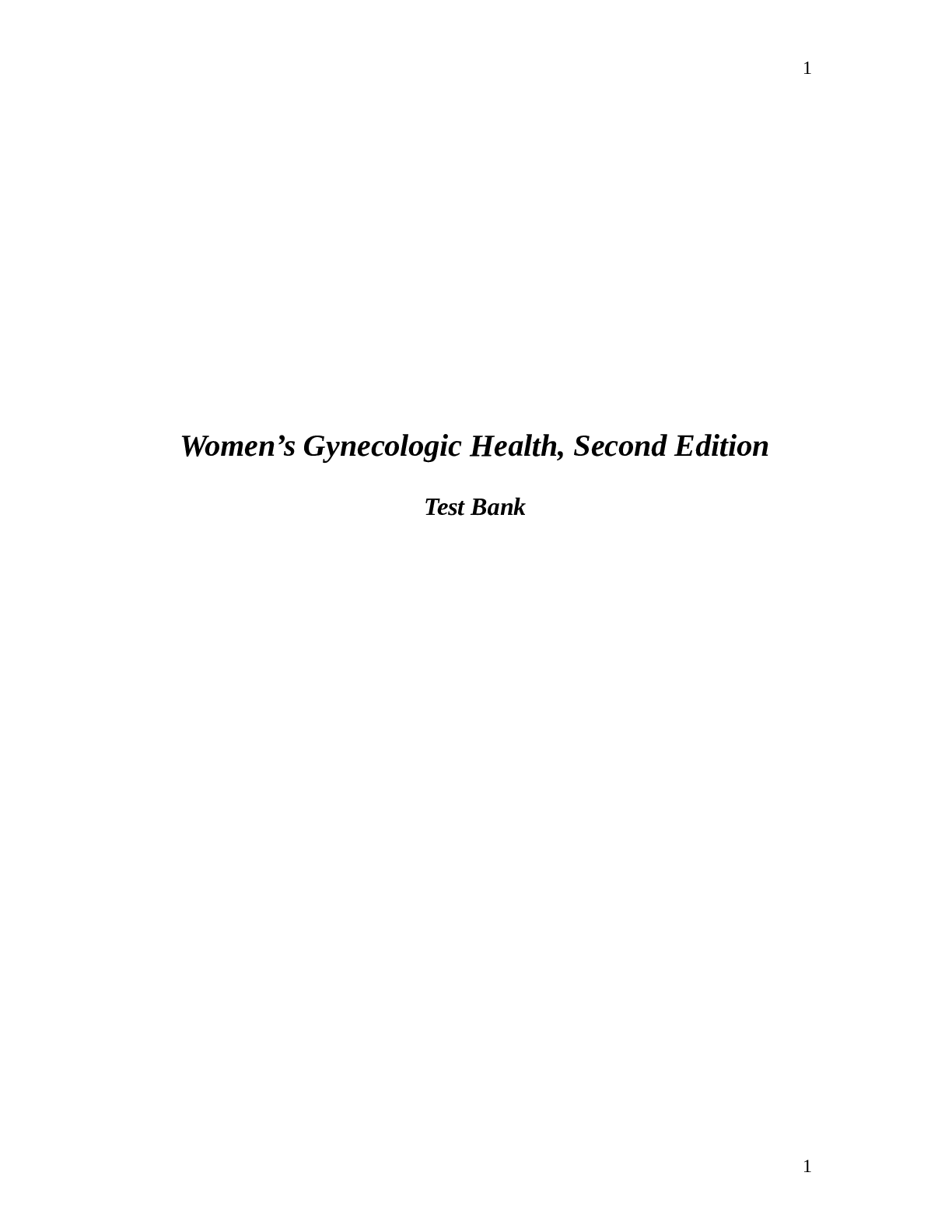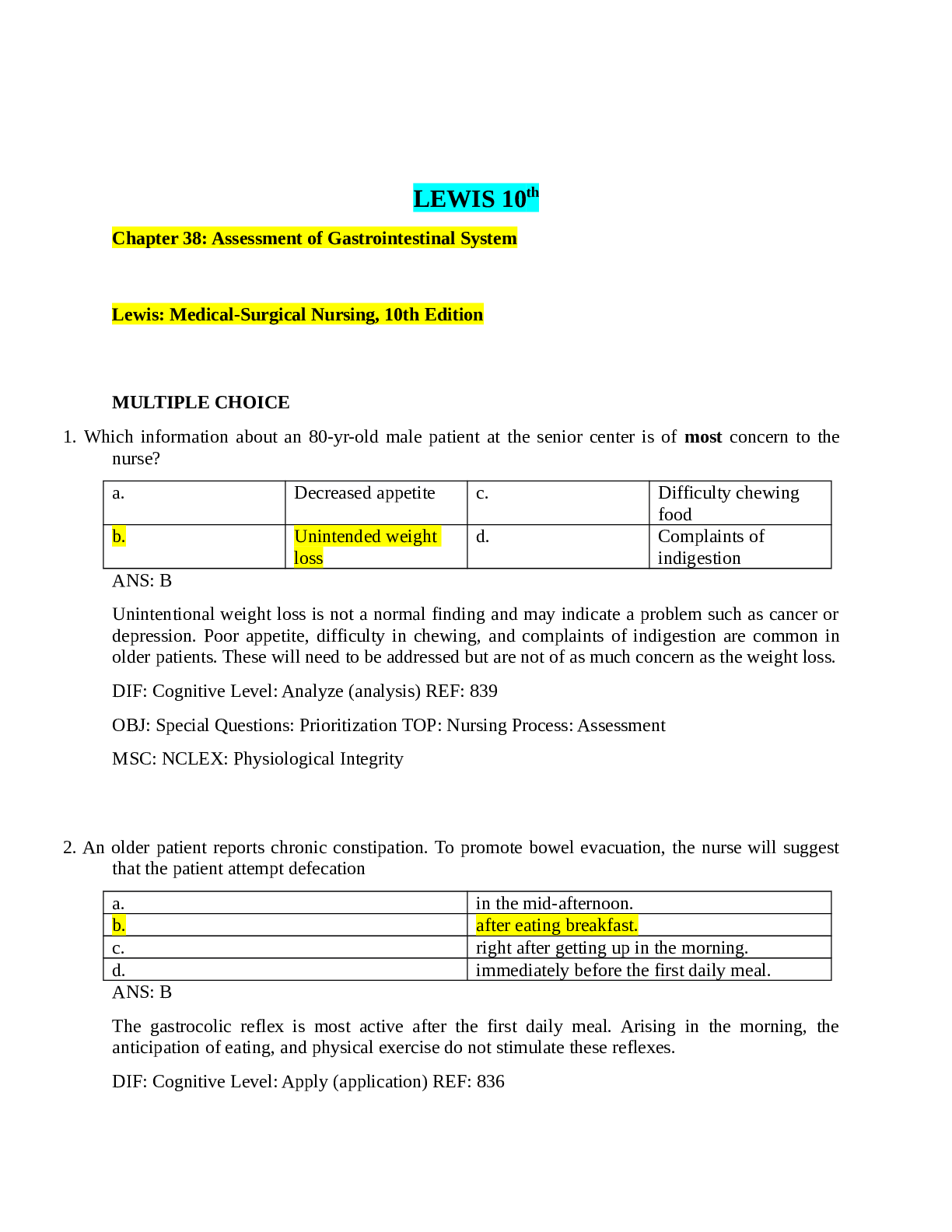*NURSING > TEST BANKS > Clinical Handbook for Brunner & Suddarths Textbook of Medical-Surgical Nursing (All)
Clinical Handbook for Brunner & Suddarths Textbook of Medical-Surgical Nursing
Document Content and Description Below
Acquired Immunodeficiency Syndrome (HIV Infection) Acquired immunodeficiency syndrome (AIDS) is defined as the most severe form of a continuum of illnesses associated with human immunodeficiency v... irus (HIV) infection. HIV belongs to a group of viruses known as retroviruses. These viruses carry their genetic material in the form of ribonucleic acid (RNA) rather than deoxyribonucleic acid. Infection with HIV occurs when it enters the host CD4+ (T) cell and causes this cell to replicate viral RNA and viral proteins, which in turn invade other CD4+ T cells. The stage of HIV disease is based on clinical history, physical examination, laboratory evidence of immune dysfunction, signs and symptoms, and infections and malignancies. The Centers for Disease Control and Prevention (CDC) standard case definition of AIDS categorizes HIV infection and AIDS in adults and adolescents on the basis of clinical conditions associated with HIV infection and CD4 + T-cell counts. Three stages of infected states have been denoted: Stage 1 or primary infection: acute/recent HIV infection, acute HIV syndrome: dramatic drops in CD4 + T lymphocyte counts >500 Stage 2: HIV symptomatic: 200 to 499 CD4 + T lymphocytes/mm3 Stage 3: AIDS: fewer than 200 CD4 + T lymphocytes/mm3 HIV Transmission HIV is transmitted through bodily fluids by high-risk behaviors such as intercourse with an HIV-infected partner and IV or injection drug use. 15 People who received transfusions of blood or blood products contaminated with HIV, children born to mothers with HIV infection, breast-fed infants of HIV-infected mothers, and health care workers exposed to needle-stick injury associated with an infected patient are also at risk. Clinical Manifestations Symptoms are widespread and may affect any organ system. Manifestations range from mild abnormalities in immune response without overt signs and symptoms to profound immunosuppression, lifethreatening infection, malignancy, and the direct effect of HIV on body tissues. Respiratory Shortness of breath, dyspnea, cough, chest pain, and fever are associated with opportunistic infections, such as those caused by Pneumocystis jiroveci (Pneumocystis pneumonia [PCP], the most common infection), Mycobacterium avium-intracellulare, cytomegalovirus (CMV), and Legionella species. HIV-associated tuberculosis occurs early in the course of HIV infection, often preceding a diagnosis of AIDS. Gastrointestinal Loss of appetite Nausea and vomiting Oral and esophageal candidiasis (white patches, painful swallowing, retrosternal pain, and possibly oral lesions) Chronic diarrhea, possibly with devastating effects (e.g., profound weight loss, fluid and electrolyte imbalances, perianal skin excoriation, weakness, and inability to perform activities of daily living) Wasting Syndrome (Cachexia) Multifactorial protein-energy malnutrition Profound involuntary weight loss exceeding 10% of baseline body weight Either chronic diarrhea (for more than 30 days) or chronic weakness and documented intermittent or constant fever with no concurrent illness Anorexia, diarrhea, gastrointestinal (GI) malabsorption, lack of nutrition 16 and, for some patients, a hypermetabolic state Oncologic Certain types of cancer occur often in people with AIDS and are considered AIDS-defining conditions. Kaposi sarcoma (KS) is the most common HIV-related malignancy and involves the endothelial layer of blood and lymphatic vessels (exhibiting a variable and aggressive course, ranging from localized cutaneous lesions to disseminated disease involving multiple organ systems). B-cell lymphomas are the second most common malignancy; they tend to develop outside the lymph nodes, most commonly in the brain, bone marrow, and GI tract. These types of lymphomas are characteristically of a higher grade, indicating aggressive growth and resistance to treatment. Invasive cervical cancer can occur. Neurologic HIV-associated neurocognitive disorders consist of cognitive impairment that is often accompanied by motor dysfunction and behavioral change. HIV-related peripheral neuropathy is common across the trajectory of HIV infection and may occur in a variety of patterns, with distal sensory polyneuropathy (DSPN) or distal symmetrical polyneuropathy the most frequently occurring type. DSPN can lead to significant pain and decreased function. HIV encephalopathy (formerly referred to as AIDS dementia complex) is a clinical syndrome that is characterized by a progressive decline in cognitive, behavioral, and motor functions. Symptoms include memory deficits, headache, difficulty in concentrating, progressive confusion, psychomotor slowing, apathy, and ataxia and, in later stages, global cognitive impairments, delayed verbal responses, a vacant stare, spastic paraparesis, hyperreflexia, psychosis, hallucinations, tremor, incontinence, seizures, mutism, and death. Cryptococcus neoformans is a fungal infection (fever, headache, malaise, stiff neck, nausea, vomiting, mental status changes, and seizures). Progressive multifocal leukoencephalopathy is a central nervous system demyelinating disorder (mental confusion, blindness, aphasia, muscle weakness, paresis, and death). Other common infections involving the nervous system include Toxoplasma gondii, CMV, and Mycobacterium tuberculosis infections. 17 Central and peripheral neuropathies include vascular myelopathy, spastic paraparesis, ataxia, and incontinence. [Show More]
Last updated: 2 years ago
Preview 1 out of 858 pages

Buy this document to get the full access instantly
Instant Download Access after purchase
Buy NowInstant download
We Accept:

Reviews( 0 )
$20.00
Can't find what you want? Try our AI powered Search
Document information
Connected school, study & course
About the document
Uploaded On
Sep 09, 2021
Number of pages
858
Written in
Additional information
This document has been written for:
Uploaded
Sep 09, 2021
Downloads
0
Views
138



.png)






.png)







.png)


